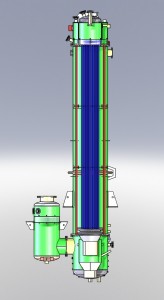Falling Film Evaporator
We ar one of the european market leaders when it comes to design and manufacturing of falling film evaporators.
Falling film evaporators are used for gentle evaporation of substances which are sensitive to heat. Typical applications are in the chemical, pharmaceutical, food processing and paper industry.

Operating Principle:
The liquid educt is evenly distributed in vertically arranged evaporator tubes. The liquid flows downwards in a thin falling film along the inside walls of the tubes. At the same time, the liquid takes up heat of the shell side heating medium and begins to evaporate. To avoid shear forces tearing off the falling film, vapour and liquid are directed downwards together to a seperator, where vapour is deposited. In order to sufficiently increase the trickling density, the product could be recycled to decouple the flow volume from the educt quantity.
Main Advantages:
The vertically arranged evaporator tubes are even sprinkled with educt in the falling film evaporator. Due to the fact, that this thin, ideally turbulent stream does not apply static pressure, the liquid starts gently boiling without superheating. The gentle treatment of the liquid which has to be evaporated is the main advantage of falling film evaporators. Valuable components like vitamins and aromas in juices or pharmaceutical ingredients in fermentation solutions are not destroyed due to small temperature differences and short contact times with the heating surface.
Due to evaporation of the liquid without superheating only small temperature differences between heating medium and product side are necessary. The small temperature difference, usually between 3°C and 8°C, also offers the possibility of saving steam through vapour-compression, evaporation and therefore lower energy costs. In addition, based on the small temperature gradient, nucleate boiling and therefore fouling on the product side can be avoided.

